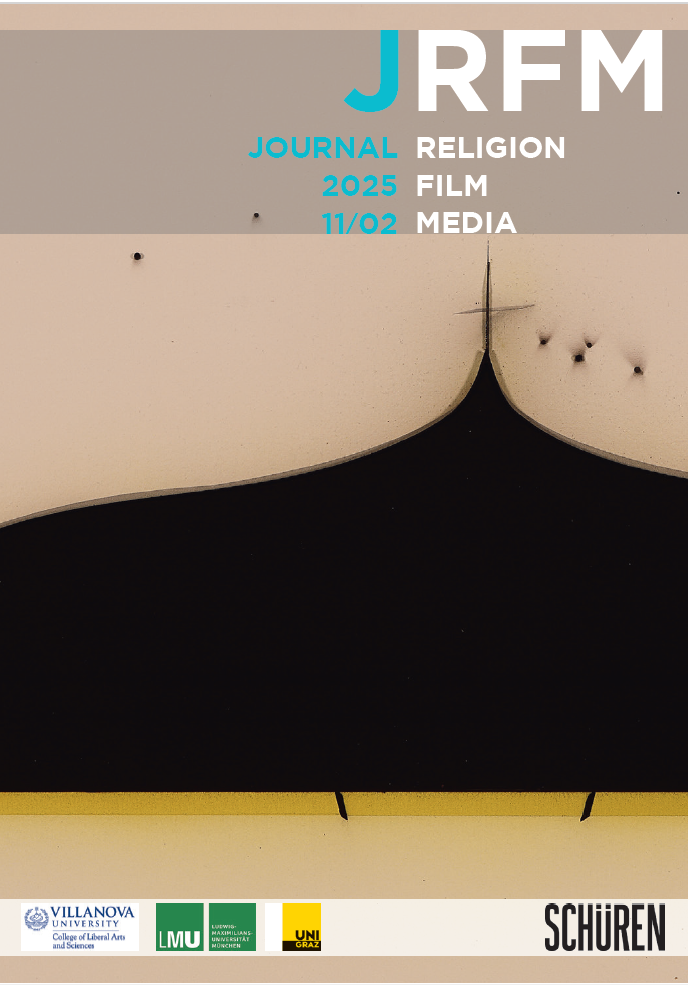About
About the Journal for Religion, Film and Media
JRFM is a peer-reviewed, open access, online publication. It offers a platform for scholarly research in the broad field of religion and media, with a particular interest in audio-visual and interactive forms of communication. It engages with the challenges arising from the dynamic development of media technologies and their interaction with religion in an interdisciplinary key. It is published twice a year, in May and November.
JRFM is edited by a network of international experts in film, media and religion with professional experience in interdisciplinary research, teaching and publishing, linking perspectives from the study of religion and theology, film, media, visual and cultural studies, and sociology. It is published in cooperation between different institutions in Europe and the USA, particularly the University of Graz, the University of Munich and Villanova University, in cooperation with the Schüren publishing house in Marburg.
Announcements
-
2025-11-15
"Representations of Islam and Muslims in Film: From Stereotype to Scenescape" – New issue of JRFM available now
Representations of Muslims and various Islamic traditions are very present in films and television series – and now also worldwide via streaming platforms. In the current issue "Representations of Islam and Muslims in Film: From Stereotype to Scenescape" researchers from various disciplines examine cinematic portrayals of Muslims and Islamic traditions using specific examples and with different focal points such as gender, identity, Shi'i islam, Sufism and diaspora. "Representations of Islam and Muslims in Film: From Stereotype to Scenescape" is now available.
-
2025-10-23
Call for Papers. Urbanity and Religion in Film
Iconic urban settings shape cinematic narration in unique ways. Landmarks like the Coliseum, the Forbidden City, the Golden Gate Bridge, the Eiffel Tower, or Chhatrapati Shivaji Maharaj Terminus in Mumbai serve not just as background to a film’s plot, but play their own part as expressions of cultural values, technical achievements, cultural exchanges and conflicts, or historical constellations. The manifold representations of urban phenomena in film are closely entangled with religious communities, institutions, traditions, practices, worldviews, or places. In this JRFM issue, we explore the multilayered interactions between urbanity and religion in mainstream films, arthouse productions, TV series, or short films.
-
2025-09-05
Call for Papers. Fandom
What do the collectible stuffed animals called Labubu have to do with religion? There is no simple answer to this question, but fandom plays a role. This is a complex field of research between politics, economic interests, and media that feeds on religious narratives and refers to specific worldviews and norms. It is about belonging and differentiation—think, for example, of all the online tests that Harry Potter fans take to find out which house at Hogwarts they belong to—and about the legitimization of ways of thinking and visions. With this issue, the editors hope to contribute to a better understanding of how religion influences fandom practices. It is less about questions of the extent to which fandom could be religion or religion a form of fandom, and more about how the various forces that drive fandom practices, e.g., economic interests, established power interests, political agendas, are fueled or expressed through religious language or iconography.
-
2025-08-05
Call for Papers. "To Believe or Not to Believe". Atheism and Nonreligion in Media and Popular Culture
Anyone who spends time in the digital space will encounter numerous websites, influencers, and videos offering ideological, spiritual, or religious content, communities, and opinions. Among them are many who define themselves as atheist or non-religious. Popular culture, such as deconversion videos or films and TV-series, also addresses the topic of atheism and nonreligion in various ways. The spring issue 2027 of JRFM aims to further explore the representation of atheism and non-religion in media and popular culture and invites authors to submit articles on this highly exciting field of research.
Volume 11, No. 2Representations of Islam and Muslims in Film. From Stereotype to Scenescape

Issue description
For decades now, the cinematic and televisual depiction of Islam in the Western media has often been reduced to a narrow set of negative stereotypes closely linked to the infamous 9/11 incident. As film and television play a powerful role in shaping public perceptions of Islam ... See the full issue
